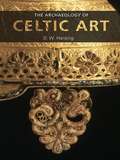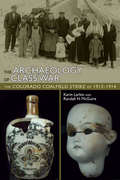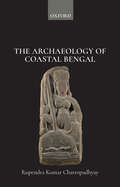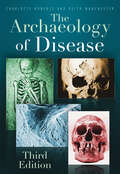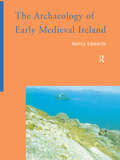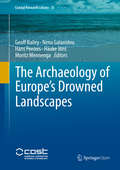- Table View
- List View
The Archaeology of Caribbean and Circum-Caribbean Farmers (6000 BC - AD 1500)
by Basil A ReidComprising 17 chapters and with a wide geographic reach stretching from the Florida Keys in the north to the Guianas in the south, this volume places a well-needed academic spotlight on what is generally considered an integral topic in Caribbean and circum-Caribbean archaeology. The book explores a variety of issues, including the introduction and dispersal of early cultivars, plant manipulation, animal domestication, dietary profiles, and landscape modifications. Tried-and-true and novel analytical techniques are used to tease out aspects of the Caribbean and circum-Caribbean database that inform the complex and often-subtle processes of domestication under varying socio-environmental conditions. Contributors discuss their findings within multiple constructs such as neolithisation, social interaction, trade, mobility, social complexity, migration, colonisation, and historical ecology. Multiple data sources are used which include but are not restricted to rock art, cooking pits and pots, stable isotopes, dental calculus and pathologies, starch grains, and proxies for past environmental conditions. Given its multi-disciplinary approaches, this volume should be of immense value to both researchers and students of Caribbean archaeology, biogeography, ethnobotany, zooarchaeology, historical ecology, agriculture, environmental studies, history, and other related fields.
The Archaeology of Caribbean and Circum-Caribbean Farmers (6000 BC - AD 1500)
by Basil A ReidComprising 17 chapters and with a wide geographic reach stretching from the Florida Keys in the north to the Guianas in the south, this volume places a well-needed academic spotlight on what is generally considered an integral topic in Caribbean and circum-Caribbean archaeology. The book explores a variety of issues, including the introduction and dispersal of early cultivars, plant manipulation, animal domestication, dietary profiles, and landscape modifications. Tried-and-true and novel analytical techniques are used to tease out aspects of the Caribbean and circum-Caribbean database that inform the complex and often-subtle processes of domestication under varying socio-environmental conditions. Contributors discuss their findings within multiple constructs such as neolithisation, social interaction, trade, mobility, social complexity, migration, colonisation, and historical ecology. Multiple data sources are used which include but are not restricted to rock art, cooking pits and pots, stable isotopes, dental calculus and pathologies, starch grains, and proxies for past environmental conditions. Given its multi-disciplinary approaches, this volume should be of immense value to both researchers and students of Caribbean archaeology, biogeography, ethnobotany, zooarchaeology, historical ecology, agriculture, environmental studies, history, and other related fields.
The Archaeology of Celtic Art
by D.W. HardingMore wide ranging, both geographically and chronologically, than any previous study, this well-illustrated book offers a new definition of Celtic art. Tempering the much-adopted art-historical approach, D.W. Harding argues for a broader definition of Celtic art and views it within a much wider archaeological context. He re-asserts ancient Celtic identity after a decade of deconstruction in English-language archaeology. Harding argues that there were communities in Iron Age Europe that were identified historically as Celts, regarded themselves as Celtic, or who spoke Celtic languages, and that the art of these communities may reasonably be regarded as Celtic art. This study will be indispensable for those people wanting to take a fresh and innovative perspective on Celtic Art.
The Archaeology of Celtic Art
by D.W. HardingMore wide ranging, both geographically and chronologically, than any previous study, this well-illustrated book offers a new definition of Celtic art. Tempering the much-adopted art-historical approach, D.W. Harding argues for a broader definition of Celtic art and views it within a much wider archaeological context. He re-asserts ancient Celtic identity after a decade of deconstruction in English-language archaeology. Harding argues that there were communities in Iron Age Europe that were identified historically as Celts, regarded themselves as Celtic, or who spoke Celtic languages, and that the art of these communities may reasonably be regarded as Celtic art. This study will be indispensable for those people wanting to take a fresh and innovative perspective on Celtic Art.
The Archaeology of Class War: The Colorado Coalfield Strike of 1913-1914
by Karin Larkin Randall H. McGuireThe Archaeology of the Colorado Coalfield War Project has conducted archaeological investigations at the site of the Ludlow Massacre in Ludlow, Colorado, since 1996. With the help of the United Mine Workers of America and funds from the Colorado State Historical Society and the Colorado Endowment for the Humanities, the scholars involved have integrated archaeological finds with archival evidence to show how the everyday experiences of miners and their families shaped the strike and its outcome.The Archaeology of Class War weaves together material culture, documents, oral histories, landscapes, and photographs to reveal aspects of the strike and life in early twentieth-century Colorado coalfields unlike any standard documentary history. Excavations at the site of the massacre and the nearby town of Berwind exposed tent platforms, latrines, trash dumps, and the cellars in which families huddled during the attack. Myriad artifacts—from canning jars to a doll’s head—reveal the details of daily existence and bring the community to life.The Archaeology of Class War will be of interest to archaeologists, historians, and general readers interested in mining and labor history.
The Archaeology of Coastal Bengal
by Rupendra Kumar ChattopadhyayResearch work on coastal Bengal has mostly focused on maritime trading networks. In a clear departure from the existing scholarship, this volume questions the linearity of considering trade as the sole determinant of creation of settlement in the coastal regions. Focusing on settlement strategies, Chattopadhyay unravels how human societies, through successive generations, have adapted to the coastal environment and bioregime. First-hand data, procured through extensive fieldwork, forms the sound basis of this work. From structural remains, ceramic and bone implements, and stone tools, to terracotta figurines and inscriptions, a vast array of sources, including epigraphic and literary sources, is analysed. Significantly, the volume also highlights the interconnection between coastal geography and the hinterland. Chattopadhyay’s meticulously researched work offers a geographical and temporal frame which allows the research on coastal Bengal to be viewed as an integral part of the archaeological developments in not only the subcontinent but also the adjoining region of the Southeast Asian countries.
An Archaeology of Colonial Identity: Power and Material Culture in the Dwars Valley, South Africa (Contributions To Global Historical Archaeology)
by Gavin LucasArchaeology of Communities: A New World Perspective
by Marcello-Andrea Canuto Jason Yaeger both atThe Archaeology of Communities develops a critical evaluation of community and shows that it represents more than a mere aggregation of households. This collection bridges the gap between studies of ancient societies and ancient households. The community is taken to represent more than a mere aggregation of households, it exists in part through shared identities, as well as frequent interaction and inter-household integration. Drawing on case studies which range in location from the Mississippi Valley to New Mexico, from the Southern Andes to the Blue Ridge Mountains of Madison County, Virginia, the book explores and discusses communities from a whole range of periods, from Pre-Columbian to the late Classic. Discussions of actual communities are reinforced by strong debate on, for example, the distinction between 'Imagined Community' and 'Natural Community.'
Archaeology of Communities: A New World Perspective
by Marcello-Andrea Canuto Jason Yaeger both atThe Archaeology of Communities develops a critical evaluation of community and shows that it represents more than a mere aggregation of households. This collection bridges the gap between studies of ancient societies and ancient households. The community is taken to represent more than a mere aggregation of households, it exists in part through shared identities, as well as frequent interaction and inter-household integration. Drawing on case studies which range in location from the Mississippi Valley to New Mexico, from the Southern Andes to the Blue Ridge Mountains of Madison County, Virginia, the book explores and discusses communities from a whole range of periods, from Pre-Columbian to the late Classic. Discussions of actual communities are reinforced by strong debate on, for example, the distinction between 'Imagined Community' and 'Natural Community.'
Archaeology of Culture Contact and Colonialism in Spanish and Portuguese America
by Pedro Paulo A. Funari Maria Ximena SenatoreThe volume contributes to disrupt the old grand narrative of cultural contact and colonialism in Spanish and Portuguese America in a wide and complete sense. This edited volume aims at exploring contact archaeology in the modern era. Archaeology has been exploring the interaction of peoples and cultures from early times, but only in the last few decades have cultural contact and material world been recognized as crucial elements to understanding colonialism and the emergence of modernity. Modern colonialism studies pose questions in need of broader answers. This volume explores these answers in Spanish and Portuguese America, comprising present-day Latin America and formerly Spanish territories now part of the United States. The volume addresses studies of the particular features of Spanish-Portuguese colonialism, as well as the specificities of Iberian colonization, including hybridism, religious novelties, medieval and modern social features, all mixed in a variety of ways unique and so different from other areas, particularly the Anglo-Saxon colonial thrust. Cultural contact studies offer a particularly in-depth picture of the uniqueness of Latin America in terms of its cultural mixture. This volume particularly highlights local histories, revealing novelty, diversity, and creativity in the conformation of the new colonial realities, as well as presenting Latin America as a multicultural arena, with astonishing heterogeneity in thoughts, experiences, practices, and, material worlds.
The Archaeology of Death and Burial
by Mike Parker PearsonThe archaeology of death and burial is central to our attempts to understand vanished societies. Through the remains of funerary rituals we can learn not only about the attitudes of prehistoric people to death and the afterlife, but also about their way of life, their social organisation and their view of the world. This ambitious book reviews the latest research in this huge and important field, and describes the sometimes controversial interpretations that have led to rapid advances in our understanding of life and death in the distant past. A unique overview and synthesis of one of the most revealing fields of research into the past, it covers archaeology's most breathtaking discoveries, from Tutankhamen to the Ice Man, and will find a keen market among archaeologists, historians and others who have a professional interest in, or general curiosity about, death and burial.
The Archaeology of Difference: Negotiating Cross-Cultural Engagements in Oceania
by Anne Clarke Robin TorrenceThe Archaeology of Difference presents a new and radically different perspective on the archaeology of cross-cultural contact and engagement. The authors move away from acculturation or domination and resistance and concentrate on interaction and negotiation by using a wide variety of case studies which take a crucially indigenous rather than colonial standpoint.
The Archaeology of Difference: Negotiating Cross-Cultural Engagements in Oceania
by Anne Clarke Robin TorrenceThe Archaeology of Difference presents a new and radically different perspective on the archaeology of cross-cultural contact and engagement. The authors move away from acculturation or domination and resistance and concentrate on interaction and negotiation by using a wide variety of case studies which take a crucially indigenous rather than colonial standpoint.
The Archaeology of Disease: Third Edition (Archaeology Ser.)
by Charlotte Roberts Keith ManchesterThe Archaeology of Disease shows how the latest scientific and archaeological techniques can be used to identify the common illnesses and injuries that humans suffered from in antiquity. In order to give a vivid picture of ancient disease and trauma the authors present the results of the latest scientific research and incorporate information gathered from documents, from other areas of archaeology and from art and ethnography. This comprehensive approach to the subject throws fresh light on the health of our ancestors and on the conditions in which they lived, and it gives us an intriguing insight into the ways in which they coped with the pain and discomfort of their existence.
Archaeology of Domestic Architecture and the Human Use of Space
by Sharon R SteadmanThis volume is the first text to focus specifically on the archaeology of domestic architecture. Covering major theoretical and methodological developments over recent decades in areas like social institutions, settlement types, gender, status, and power, this book addresses the developing understanding of where and how people in the past created and used domestic space. It will be a useful synthesis for scholars and an ideal text for advanced undergraduate and graduate courses in archaeology and architecture. The book-covers the relationship of architectural decisions of ancient peoples with our understanding of social and cultural institutions;-includes cases from every continent and all time periods-- from the Paleolithic of Europe to present-day African villages;-is ideal for the growing number of courses on household archaeology, social archaeology, and historical and vernacular architecture.
Archaeology of Domestic Architecture and the Human Use of Space
by Sharon R SteadmanThis volume is the first text to focus specifically on the archaeology of domestic architecture. Covering major theoretical and methodological developments over recent decades in areas like social institutions, settlement types, gender, status, and power, this book addresses the developing understanding of where and how people in the past created and used domestic space. It will be a useful synthesis for scholars and an ideal text for advanced undergraduate and graduate courses in archaeology and architecture. The book-covers the relationship of architectural decisions of ancient peoples with our understanding of social and cultural institutions;-includes cases from every continent and all time periods-- from the Paleolithic of Europe to present-day African villages;-is ideal for the growing number of courses on household archaeology, social archaeology, and historical and vernacular architecture.
The Archaeology of Early Medieval and Medieval South Asia: Contesting Narratives from the Eastern Ganga-Brahmaputra Basin
by Swadhin Sen Supriya Varma Bhairabi Prasad SahuThis book looks at the ways in which archaeological methods have been used in debates concerning the early medieval and medieval periods in South Asia. Despite the incorporation and use of archaeological data to corroborate historical narratives, the theories and methods of archaeology are largely ignored in and excluded from the dominating, institutionalized and hegemonic disciplinary discourses. The volume offers contesting insights, polemical narratives, and new data from archaeological contexts to initiate a debate on many foundational premises of archaeological and historical narratives. It focuses on the much-neglected region of the Eastern Ganga-Brahmaputra Basin as a spatial frame to do this, and studies themes such as spatial and temporal scales of concepts and methods, multi-scaler factors and processes of continuity and changes, the settlement archaeology on alluvial landscape, changing patterns of agrarian transformation, and material cultures, including coins, inscriptions, pottery, sculptures, in their contexts in sub-regional, regional and supra-regional intersections. As a crucial and unprecedented intervention in the study of the early medieval and the medieval periods, this volume will be useful for scholars and researchers of archaeology, ancient history, medieval history, water history, earth sciences, palaeoecology, historical ecology, epigraphy, art history, material culture studies, Indian history, and South Asian Studies in general.
The Archaeology of Early Medieval and Medieval South Asia: Contesting Narratives from the Eastern Ganga-Brahmaputra Basin
by Swadhin Sen, Supriya Varma, and Bhairabi Prasad SahuThis book looks at the ways in which archaeological methods have been used in debates concerning the early medieval and medieval periods in South Asia. Despite the incorporation and use of archaeological data to corroborate historical narratives, the theories and methods of archaeology are largely ignored in and excluded from the dominating, institutionalized and hegemonic disciplinary discourses. The volume offers contesting insights, polemical narratives, and new data from archaeological contexts to initiate a debate on many foundational premises of archaeological and historical narratives. It focuses on the much-neglected region of the Eastern Ganga-Brahmaputra Basin as a spatial frame to do this, and studies themes such as spatial and temporal scales of concepts and methods, multi-scaler factors and processes of continuity and changes, the settlement archaeology on alluvial landscape, changing patterns of agrarian transformation, and material cultures, including coins, inscriptions, pottery, sculptures, in their contexts in sub-regional, regional and supra-regional intersections. As a crucial and unprecedented intervention in the study of the early medieval and the medieval periods, this volume will be useful for scholars and researchers of archaeology, ancient history, medieval history, water history, earth sciences, palaeoecology, historical ecology, epigraphy, art history, material culture studies, Indian history, and South Asian Studies in general.
The Archaeology of Early Medieval Ireland
by Nancy EdwardsIn the first major work on the subject for over 30 years, Nancy Edwards provides a critical survey of the archaeological evidence in Ireland (c. 400-1200), introducing material from many recently discovered sites as well as reassessing the importance of earlier excavations. Beginning with an assessment of Roman influence, Dr Edwards then discusses the themse of settlement, food and farming, craft and technology, the church and art, concluding with an appraisal of the Viking impact. The archaeological evidence for the period is also particularly rich and wide-ranging and our knowledge is expanding repidly in the light of modern techniques of survey and excavation.
The Archaeology of Early Medieval Ireland
by Nancy EdwardsIn the first major work on the subject for over 30 years, Nancy Edwards provides a critical survey of the archaeological evidence in Ireland (c. 400-1200), introducing material from many recently discovered sites as well as reassessing the importance of earlier excavations. Beginning with an assessment of Roman influence, Dr Edwards then discusses the themse of settlement, food and farming, craft and technology, the church and art, concluding with an appraisal of the Viking impact. The archaeological evidence for the period is also particularly rich and wide-ranging and our knowledge is expanding repidly in the light of modern techniques of survey and excavation.
Archaeology of Entanglement
by Lindsay Der Francesca FernandiniEntanglement theory posits that the interrelationship of humans and objects is a delimiting characteristic of human history and culture. This edited volume of original studies by leading archaeological theorists applies this concept to a broad range of topics, including archaeological science, heritage, and theory itself. In the theoretical explications and ten case studies, the editors and contributing authors: • build on the intersections between science, humanities and ecology to provide a more fine-grained, multi-scalar treatment emanating from the long-term perspective that characterizes archaeological research; • bring to light the subtle and unacknowledged paths that configure historical circumstances and bind human intentionality; • examine the constructions of personhood, the rigidity of path dependencies, the unpredictable connections between humans and objects and the intricate paths of past events in varied geographic and historical contexts that channel future actions. This broad focus is inclusive of early complex developments in Asia and Europe, imperial and state strategies in the Andes and Mesoamerica, continuities of postcolonialism in North America, and the unforeseen and complex consequences that derive from archaeological practices. This volume will appeal to archaeologists and their advanced students.
Archaeology of Entanglement
by Lindsay Der Francesca FernandiniEntanglement theory posits that the interrelationship of humans and objects is a delimiting characteristic of human history and culture. This edited volume of original studies by leading archaeological theorists applies this concept to a broad range of topics, including archaeological science, heritage, and theory itself. In the theoretical explications and ten case studies, the editors and contributing authors: • build on the intersections between science, humanities and ecology to provide a more fine-grained, multi-scalar treatment emanating from the long-term perspective that characterizes archaeological research; • bring to light the subtle and unacknowledged paths that configure historical circumstances and bind human intentionality; • examine the constructions of personhood, the rigidity of path dependencies, the unpredictable connections between humans and objects and the intricate paths of past events in varied geographic and historical contexts that channel future actions. This broad focus is inclusive of early complex developments in Asia and Europe, imperial and state strategies in the Andes and Mesoamerica, continuities of postcolonialism in North America, and the unforeseen and complex consequences that derive from archaeological practices. This volume will appeal to archaeologists and their advanced students.
The Archaeology of Ethnicity: Constructing Identities in the Past and Present
by Siân JonesThe question of ethnicity is highly controversial in contemporary archaeology. Indigenous and nationalist claims to territory, often rely on reconstructions of the past based on the traditional identification of 'cultures' from archaeological remains. Sian Jones responds to the need for a reassessment of the ways in which social groups are identified in the archaeological record, with a comprehensive and critical synthesis of recent theories of ethnicity in the human sciences. In doing so, she argues for a fundamentally different view of ethnicity, as a complex dynamic form of identification, requiring radical changes in archaeological analysis and interpretation.
The Archaeology of Ethnicity: Constructing Identities in the Past and Present
by Siân JonesThe question of ethnicity is highly controversial in contemporary archaeology. Indigenous and nationalist claims to territory, often rely on reconstructions of the past based on the traditional identification of 'cultures' from archaeological remains. Sian Jones responds to the need for a reassessment of the ways in which social groups are identified in the archaeological record, with a comprehensive and critical synthesis of recent theories of ethnicity in the human sciences. In doing so, she argues for a fundamentally different view of ethnicity, as a complex dynamic form of identification, requiring radical changes in archaeological analysis and interpretation.
The Archaeology of Europe’s Drowned Landscapes (Coastal Research Library #35)
by Geoff Bailey Nena Galanidou Hans Peeters Hauke Jöns Moritz MennengaThis open access volume provides for the first time a comprehensive description and scientific evaluation of underwater archaeological finds referring to human occupation of the continental shelf around the coastlines of Europe and the Mediterranean when sea levels were lower than present. These are the largest body of underwater finds worldwide, amounting to over 2500 find spots, ranging from individual stone tools to underwater villages with unique conditions of preservation. The material reviewed here ranges in date from the Lower Palaeolithic period to the Bronze Age and covers 20 countries bordering all the major marine basins from the Atlantic coasts of Ireland and Norway to the Black Sea, and from the western Baltic to the eastern Mediterranean. The finds from each country are presented in their archaeological context, with information on the history of discovery, conditions of preservation and visibility, their relationship to regional changes in sea-level and coastal geomorphology, and the institutional arrangements for their investigation and protection. Editorial introductions summarise the findings from each of the major marine basins. There is also a final section with extensive discussion of the historical background and the legal and regulatory frameworks that inform the management of the underwater cultural heritage and collaboration between offshore industries, archaeologists and government agencies. The volume is based on the work of COST Action TD0902 SPLASHCOS, a multi-disciplinary and multi-national research network supported by the EU-funded COST organisation (European Cooperation in Science and Technology). The primary readership is research and professional archaeologists, marine and Quaternary scientists, cultural-heritage managers, commercial and governmental organisations, policy makers, and all those with an interest in the sea floor of the continental shelf and the human impact of changes in climate, sea-level and coastal geomorphology.

